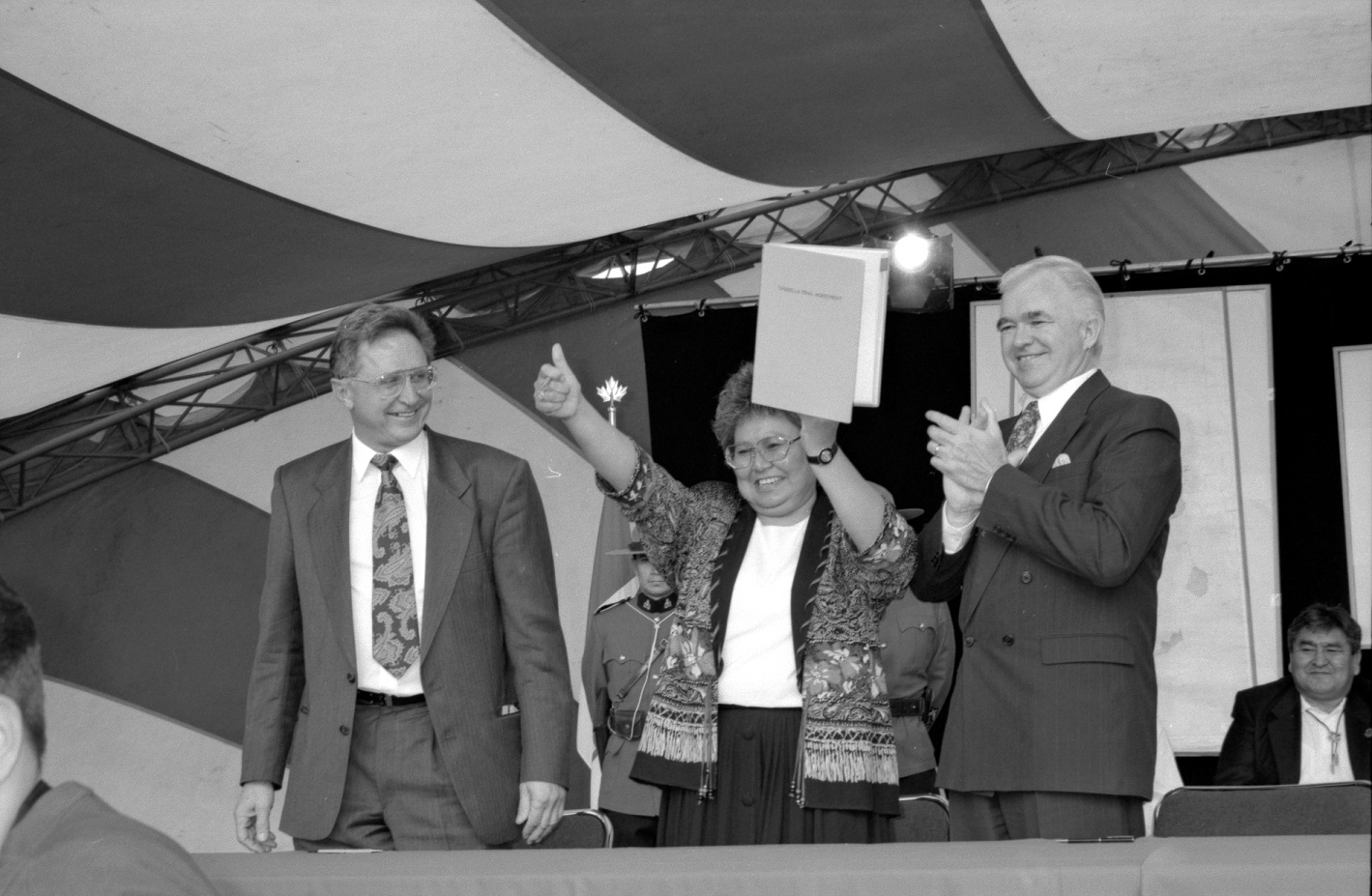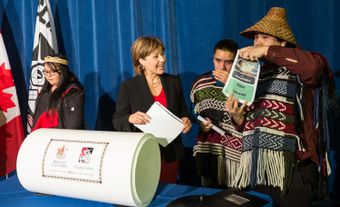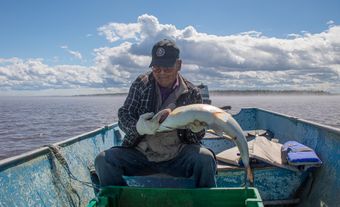There are 14 First Nations in Yukon. Eleven of these nations are self-governing, while the remaining three are governed under the Indian Act. The 11 self-governing First Nations have legislative and executive powers much like a province or territory. In 1993, they signed the Umbrella Final Agreement (UFA) with the governments of Canada and Yukon. The UFA served as the foundation for individual self-governing agreements made between each First Nation and the territorial and federal governments. These individual agreements were signed between 1993 and 2006. (See also Comprehensive Land Claims.) While the focus of this article is the 11 self-governing First Nations, the remaining three First Nations in Yukon are White River, Liard and Ross River.

This map depicts the traditional territories of the 11 self-governing First Nations in Yukon.
Which Yukon First Nations Are Self-Governing?
The 11 self-governing First Nations in Yukon are:
- Champagne and Aishihik First Nations
- First Nation of Na-Cho Nyäk Dun
- Teslin Tlingit Council
- Vuntut Gwitchin First Nation
- Little Salmon/Carmacks First Nation
- Selkirk First Nation
- Tr’ondëk Hwëch’in
- Ta’an Kwäch’än Council
- Kluane First Nation
- Kwanlin Dün First Nation
- Carcross/Tagish First Nation
Linguistic Groups
First Nations in Yukon speak eight Indigenous languages. Seven of these languages are part of the Athapaskan language family, namely Gwich’in, Hän, Upper Tanana, Northern Tutchone, Southern Tutchone, Tagish and Kaska. The eighth language, Tlingit, is distantly related to the Athapaskan language family.
There is considerable language crossover between First Nations. Many Kwäday Dän (“Long Ago People” in Southern Tutchone) spoke multiple languages and within each language there are multiple dialects. For example, many Southern Tutchone traded with coastal Alaska Tlingit nations. They formalized trade through acknowledged partnerships and marriage, therefore, the majority of Southern Tutchone could speak both languages. Today, all Yukon First Nations are committed to the preservation and enhancement of their language.
History
Traditionally, families were large and, in many regions, men and women had more than one marriage. Most cultures followed a matrilineal clan system, where children belonged to the same clan as their mother and married outside of their own clan. Clans were responsible for land, played a role in trade organization and cared for land and animals. Children were raised by many. When very small, grandparents, who moved at the same speed, were caretakers and teachers. Once older and nearing puberty, aunts and uncles on the mother’s side (same clan) took on education, ensuring young women were proficient sewers and young men were strong hunters.
Every individual was raised to be resourceful and mindful. The culture demanded that people were physically, emotionally, mentally and spiritually strong. If a person was imbalanced, if they neglected their spirit and prioritized their body, there would be consequences, such as an unsuccessful hunt. In a culture so closely connected to the land, there was no luxury for haphazard behaviour. People were constantly busy; everyone knew their role and purpose. The culture provided the education, experience and knowledge to ensure people were always whole and always prepared — they never got stuck. They were resourceful and self-reliant within the social groupings of First Nation, community and family.
The yearly cycle was closely linked to the seasons and animal migrations. Small family units continuously travelled from river and lake breakup in the spring until freeze-up in the late fall. They harvested food, such as salmon, caribou and cranberries, along with medicine, such as balsam, lungwort and yarrow. Food was stored in high or ground caches across the homeland for winter. The cold months could be harsh. There are many stories of no animals and starvation. Over winter, families trapped, hunted, netted fish under ice and continued to be busy as they awaited the returning birds.
Contact and Fur Trade
In the 1700s, Tlingit Nations on the coast of Alaska traded with the Russians, bringing goods inland. The Russians introduced the concept of ownership and trade for property, where one gun cost the gun’s height in stacked fur pelts. Seasonal patterns shifted as families from across the Yukon travelled to trade centres with their winter’s fur harvest to exchange for imported Russian goods.
The first known non-Indigenous peoples to enter Yukon were Hudson’s Bay Company fur traders in the 1800s. They established trade posts from the south (Kaska Dene territory) to the north (Vuntut Gwitchin First Nation territory). Traders brought tea, flour and tools, which First Nations used as they continued their way of life. The fur trade was the primary economic and relationship driver between Yukon First Nations and non-Indigenous outsiders until 1896, when gold was discovered in the Klondike.
Klondike Gold Rush
The Klondike Gold Rush brought about 40,000 people to Yukon between 1896 and 1899. The prospectors employed First Nations people as packers and guides. Despite the help of these First Nation guides, many cheechakos, or newcomers, perished. By 1905, the majority of the gold seekers had left the territory.

Studio portrait of a First Nations packer during the Klondike Gold Rush, c. 1898.
The impact of the gold rush was profound. In 1902, Jim Boss, chief of the Ta'an Kwäch'än, wrote to Ottawa calling on the federal government to protect Indigenous peoples’ land and resources. The government responded half-heartedly, saying the police would protect his people and their land. By this time, treaties between First Nations and the federal government covered much of Canada. For example, by 1905, nine of Canada’s 11 Numbered Treaties had been signed, including Treaty 8, which covers much of the land to the southeast of Yukon. The government wanted to promote this area as an “all-Canadian” access route to the goldfields. The government’s policy, however, was to offer treaties only in areas where they expected long-term economic development and white settlement. Believing that the gold rush was a one-time event, the government did not offer a treaty to Yukon First Nations.
Residential Schools and Alaska Highway
Following the gold rush, significant and rapid change came to Yukon. Two catalysts for this change were residential schools and the Alaska Highway. Four residential schools operated in the Yukon between 1903 and 1985. As with residential schools elsewhere in the country, these institutions wreaked havoc on the lives of First Nation people.
During the Second World War, the Alaska Highway was built from Dawson Creek, British Columbia, to Big Delta, Alaska, cutting through southwestern Yukon along the way.
First Nation citizens moved to places along the highway to find work. In addition, the federal government forced First Nation people to relocate to administrative centres to “benefit” from education and social services. These forced relocations immearsurably affected the migratory way of life of most First Nations. Everything about the economic, social, cultural and spiritual way of Indigenous people was disrupted during this time.
Together Today for Our Children Tomorrow

In 1973, Elijah Smith (first on the right in the front row) led a group of Yukon First Nation leaders to Ottawa. The delegation, pictured here on the steps of the Parliament Buildings, convinced the federal government to begin land claim negotiations.
In 1973, an organization called the Yukon Native Brotherhood (YNB), led by Chief Elijah Smith and a delegation of Yukon chiefs, presented a statement of grievances and an approach to just settlement to Prime Minister Pierre Trudeau. Their historic document was titled Together Today for Our Children Tomorrow. At the time, there were 12 First Nations in Yukon, and the YNB represented all of them. Their main messages were: we must break the back of dependency created by government programs such as welfare, we want help to succeed, and we are not looking for a handout. “The objective of the Yukon Indian people,” they wrote, “is to obtain a Settlement in place of a treaty that will help us and our children learn to live in a changing world.”
Trudeau agreed to work with the YNB, marking the first time in Canada a comprehensive land claim was accepted for negotiation.
Self-Government Negotiations
There were many hurdles during the 20-year period between 1973 and 1993, when the Umbrella Final Agreement was signed. Some were between First Nations and Canada and Yukon, such as settlement land selection and decision-making authority. Others were internal to First Nations, such as whether to include individuals without Indian Status, or the balance between monetary compensation and self-determination.
In 1984, negotiations completely broke down. The Yukon First Nations people voted to reject a settlement offer that provided significant compensation, but not self-government or co-management of Yukon land and resources. Of this decision the Vuntut Gwichin Chief Joe Linklater said, “One of the toughest decisions of my life was to walk away from an agreement for over $600 million.” In 1985, all parties returned to the table. Over the following eight years, they worked together to create a vision for all Yukon children of tomorrow.
Umbrella Final Agreement and First Nation Final Agreements
On 29 May 1993, 11 Yukon First Nations, and the governments of Canada and Yukon signed the Umbrella Final Agreement (UFA). The UFA is not a legal document, but rather a political agreement between the First Nations signatories, Yukon and Canada. It provides the foundation for all 11 of the Yukon First Nation Final Agreements. Unlike the UFA, these agreements are legal, constitutionally protected documents.

From left to right John Ostashek, government leader of Yukon; Judy Gingell, chair of the Council of Yukon Indians; and Tom Siddon, minister of Indian Affairs and Northern Development Canada. Gingell celebrates after signing the Umbrella Final Agreement on 29 May 1993.
Between 1993 and 2006, the 11 First Nations, using the UFA as the foundation, negotiated First Nation-specific agreements with the territorial and federal governments. These agreements selected areas of land and added unique features important to specific First Nations. For example, the Kluane First Nation negotiated a wild sheep harvest tag in the agreement as an economic development measure. These hunts sell at auction for significant value to the First Nation. Some agreements took more time due to their complexity. Kwanlin Dün First Nation and the Ta’an Kwäch’än Council, for example, both based in the Whitehorse area, needed to address their relationship with the City of Whitehorse in addition to the other levels of government.
In 1993, four First Nations finalized agreements: Champagne and Aishihik First Nations, First Nation of Na-Cho Nyäk Dun, Teslin Tlingit Council and Vuntut Gwitchin First Nation. In 1997, Little Salmon/Carmacks First Nation and the Selkirk First Nation finalized their agreements, followed by the Tr’ondëk Hwëch’in First Nation in 1998. The remaining four First Nations signed agreements in the early 2000s: Ta’an Kwäch’än Council in 2002, Kluane First Nation in 2003, Kwanlin Dün First Nation in 2005 and Carcross/Tagish First Nation in 2006.
I believe the future, or the children of tomorrow, is the “intent” of the final agreements. Working together in pursuit of prosperous, harmonious possibility is the “spirit.” The Yukon remains young. It is still coming into its own as a unique place of governance and aspiration. Yukon First Nations are actively reconnecting to and revitalizing their culture, language and way of life. Now the struggle is to find the balance between the ancestor’s way and the modern way, both in terms of daily life, but also in terms of governance. Fortunately, the healing path towards independence is held in our stories, our land and our languages. The ancestors provided the tools. It is up to us to wield them.
- Author Jocelyn Joe-Strack, Wolf Clan, Champagne and Aishihik First Nation
Both the UFA and the nation-specific final agreements express a vision for the co-management of governance. Academics and Indigenous signatories often describe this vision as part of the “spirit and intent” of modern treaties. There are many interpretations of modern treaties’ spirit and intent. With respect to the Yukon, a notable example came in a decision made by the Supreme Court of Canada in 2017. Several parties, including the First Nation of Na-Cho Nyäk Dun, Tr’ondëk Hwëch’in and Vuntut Gwitchin First Nation, brought a case concerning the Peel Watershed in northeastern Yukon. In creating a land use plan for the area, the First Nations argued that the territorial government had not followed the consultation process laid out in their final agreements. The Supreme Court supported the First Nations’ argument. “The UFA is a model for reconciliation,” the judges wrote. “This framework establishes institutions for self-government and the management of lands and resources. The Final Agreements falling under the UFA are intended to foster a positive and mutually respectful long-term relationship between the signatories…In this way, the Final Agreements must address past grievances, and yet are orientated towards the future.”
Governance
The Yukon’s 11 self-governing First Nations have their own self-government agreements. These recognize their right to develop their own constitutions, and pass laws for their own settlement land and citizens. For example, nations may enact policy for land management, justice, or education. Each nation has created or embraced a different model of governance.
Selection of chief and councillors is mostly through popular election, but that’s not always the case. Some First Nations, like the Teslin Tlingit Council, recognize the authority of their clans (Kukhhittan, Ishkitan, Yanyedi, Deshitan and Dakhlawedi) to appoint members to both the executive council and the general council. First Nation representatives sit on land claims boards and in leadership positions within the Yukon Government. Yukon First Nations are key contributors, as envisioned in Together Today for our Children Tomorrow, to the Yukon’s economy. They have leadership roles in energy innovation, land and resource management, and education.

 Share on Facebook
Share on Facebook Share on X
Share on X Share by Email
Share by Email Share on Google Classroom
Share on Google Classroom



